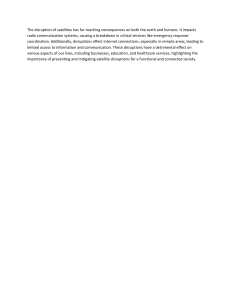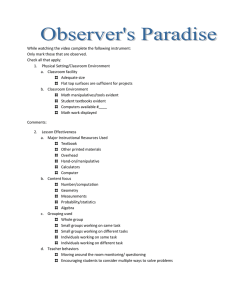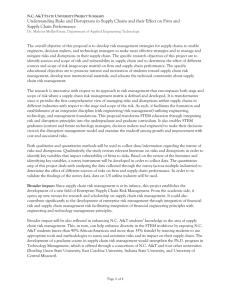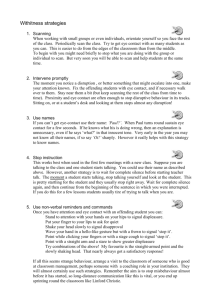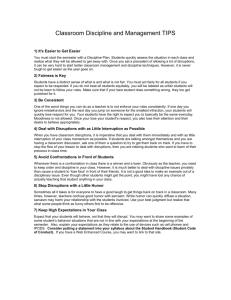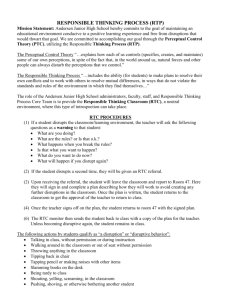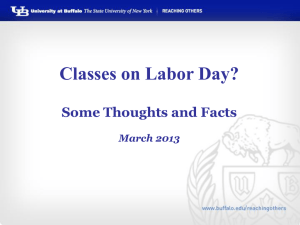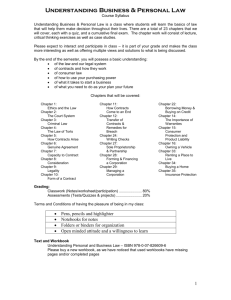(2009) on dealing with disruptive students
advertisement
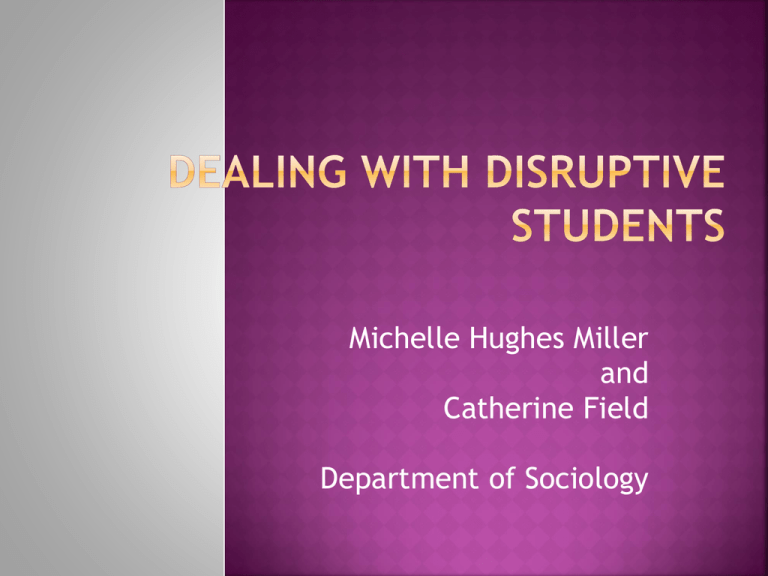
Michelle Hughes Miller and Catherine Field Department of Sociology 1) Students WITH problems 2) Students AS problems, or Disruptive Students What kinds of “problems” do students bring with them to our classrooms? What kinds of “problems” can students cause for teachers or in our classrooms? Most disturbing forms of CI: Student conversations Students who make sarcastic or critical comments Students who have emotional and unpredictable outbursts FACULTY PERSPECTIVES STUDENT PERSPECTIVES 1. Side Conversations 1. Side Conversations 2. Arriving late/leaving early 2. Cell phone issues 3. Inappropriate laptop use 3. Group project issues 4. Cell phone issues 4. Over-the-top participators 5. Newspapers/Sudoku 5. Inappropriate laptop use 6. Sleeping in class 6. Food issues 7. Failure to prepare for class 7. Unprepared for class Students’ problems may become class problems. Class problems may create student problems. Listener Source of referral TRIAGE Student Health Center, 453-3311 The Counseling Center, 453-5371 The Clinical Center, 453-2361 Financial Aid Office, 453-4334 Students’ Legal Assistance, 536-6677 International Programs and Services, 536-7771 Disability Support Services, 453-5738 The Women’s Center, 529-2324 You can PREVENT their problems from affecting your class and you; or You can INTERVENE to stop or prevent further class problems. Class disruptions affect you and the other students in the class. Class disruptions sometimes reflect underlying class problems– find out! Class disruptions or responses to class disruptions may lead to frustration or anger in the student, their peers, or the instructor. Students’ dislike of a class or a teacher Students’ and Teachers’ disrespect of each other Teachers’ alienation of students through poor teaching strategies Teachers who fail to deal with class disruptions Teachers can PREVENT and/or REDUCE classroom incivilities by changing their own behaviors. 1) Place all of YOUR important class rules in your syllabus. • Violations should have stated consequences. 2) Model respect and interest in your students. • • • • Learn names Begin and end class on time Engage the students; use positive motivators Involve students in a discussion of class expectations 3) Pay attention to class dynamics (body language, comments, grades) and adjust class activities accordingly. • Is the material difficult? Do students need a break? Are you moving too quickly? 4) Respond to minor disruptions quickly and politely by reminding students of class rules Be TIMELY. Choose a response that is STUDENTFRIENDLY. Be FAIR. Don’t duck controversy. Listen, and get students to listen to one another. Keep your cool. Paraphrase, question, and summarize. Talk to colleagues. Ask what they do. Remember that your problem students are human beings Two or three students in your class seem to enjoy talking to each other more than listening to you. You asked them once to pay attention, but the next day they went back to their private conversation. Some of the students who sit near them appear to be bothered by the distraction, but others act like they enjoy the conversation. You are afraid you are losing control of that part of the classroom. You believe that arriving late to class is a sign of disrespect to the teacher and the other students. It is also very distracting. Every day, at least five students arrive late to your large introductory class. So far you have not said anything to the late arrivals. You do not have to put up with threatening or rude behavior just because you are a Teaching Assistant! Keep your cool! Do NOT engage in a heated debate with the student during or after class. If you can not defuse the situation, arrange to meet with the student later in your office. Humor and active listening can often defuse situations. Be sure a third party is available to sit in on that meeting. If you are worried about your immediate safety or the safety of others, call 911 immediately. Before a problem becomes serious. After an exchange with a student. Any time you need advice on how to deal with a disruptive student. Students may be disruptive because of personal issues or classroom or teaching dynamics. Teachers CAN and SHOULD respond to disruptive students. It is easier to PREVENT class disruptions than to INTERVENE once they have begun. Teachers can prevent or reduce class disruptions through their syllabus or by changing their own classroom interactions. Teachers can intervene to prevent further class disruptions by being timely, studentfriendly and fair.

